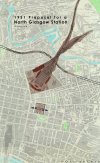The 'Type B' versions of the AC electrics geared for 80mph were intended to meet a specification for ECML freight work.
The better posters on that site have excruciatingly detailed historical references that would put many railway enthusiasts to shame. NOMISSYRUC is one of them, and is normally very good at clearly identifying what's fact and what's fiction.
There was early consideration of what became the Transpennine units working Liverpool & Manchester to Birmingham. This was abandoned as electric units were planned for the route.
The Glasgow Corporation had some very ambitious plans around this time to electrify basically the entire suburban railway network, including construction of new stations to serve new housing developments and the construction of a new Glasgow North station on the Buchanan Street, with diversion of the E&G main line before Cowlairs Tunnel. Queen Street station would have become a bus station, alongside the Anderston bus station.
Those proposals excluded those parts of the WCML that only carried long-distance traffic, and some freight-only lines, presumably on the grounds that it was only concerned with local passenger transport.
This was all part of the same transport planning that gave Glasgow the Inner Ring Road.
Can you advise what these 'Type B' versions were? Not a term I've seen before in this context. How did the ECML freight specification differ materially from the WCML, especially in terms of King's Cross Leeds/York? The core WCML spec for freight was a notional 950-ton freight between Willesden and Longsight at a maximum of 55mph or a lighter, fully-fitted, freight at a maximum of 60mph. Obviously this pre-dated modern heavy axleloads, 75mph container trains and so on.
How early were Transpenninne Class 124 lookalikes envisaged for Liverpool/Manchester-Birmingham, bearing in mind that electrification was envisaged from 1955 and well in hand before the units came along, around 1960?
Much more might be written about urban planning by Glasgow Corporation but the 1949 'Fitzpayne' plan actually envisaged creation of a distinct 'rapid transit' mode, taking over some suburban rail lines and some new construction, including tunnelling. This appeared to supplant most of what we think of as the 'North' and 'South' Electrics and what became the Argyle Line.
Much of what is often presented as 'plans', especially around 70 years later, seems to me to have been of the aspiration/vision nature rather than what I think of in terms of firm proposals for particular outputs based on commercial/efficiency/obsolescence need, resources required, timescales, business case and a funding proposal (capital grant, borrowing, external contribution or whatever).

